Honey Giant Tomato: Large and Fruitful
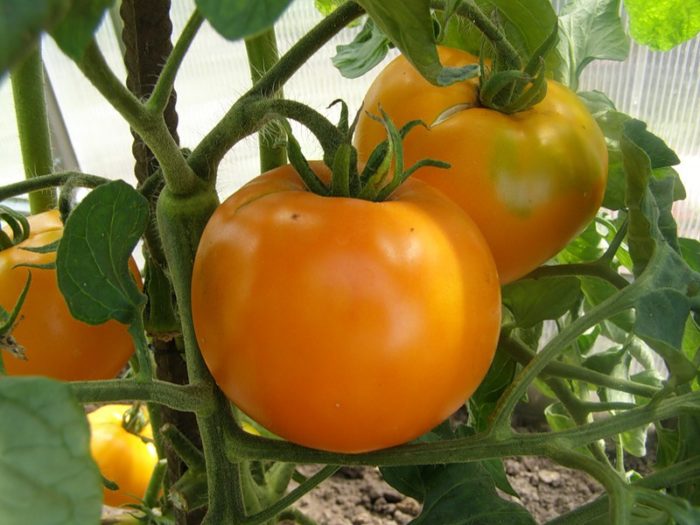
Yellow tomato varieties contain a richer vitamin and mineral composition, do not cause allergies. They perfectly cleanse and rejuvenate the body, are the prevention of serious diseases.
general information
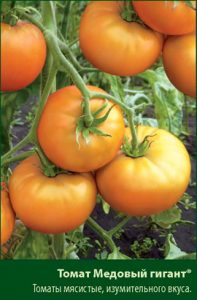 This variety was bred at the beginning of the millennium, namely in 2002 by Russian breeders. Two years later, it was brought to the state register, since then tomatoes have been actively grown, and they have won the hearts of absolutely all summer residents with their performance. If we talk about growing regions, warm areas of the south are ideal for cultivation in the open field, yet the rest can grow this variety in greenhouses - film or polycarbonate. The peculiarity of “Honey Giant” is that it is sensitive to temperature extremes. But, of course, he has much more advantages, about them further.
This variety was bred at the beginning of the millennium, namely in 2002 by Russian breeders. Two years later, it was brought to the state register, since then tomatoes have been actively grown, and they have won the hearts of absolutely all summer residents with their performance. If we talk about growing regions, warm areas of the south are ideal for cultivation in the open field, yet the rest can grow this variety in greenhouses - film or polycarbonate. The peculiarity of “Honey Giant” is that it is sensitive to temperature extremes. But, of course, he has much more advantages, about them further.
Characteristics and description
Description of the bush
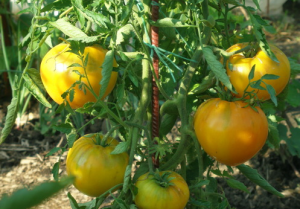 Honey Giant Tomatoes are powerful bushes that can reach more than 1.5 meters in height. In greenhouse conditions, the height can be even greater.
Honey Giant Tomatoes are powerful bushes that can reach more than 1.5 meters in height. In greenhouse conditions, the height can be even greater.
Therefore, they need support. Shrubs form, for maximum yield, it is better to leave 2 stalks - the main and the stepson in the first, upper sinus. Therefore, we conclude that the variety requires pasynkovaniya. The number of leaves on the bushes is average, the branches are powerful, they hold large fruits well, but still it is better to set backwaters.
Bushes are demanding to moisture and soil nutrition, belong to the indeterminant type.
Fruit
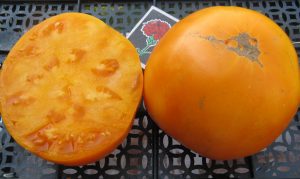 This variety is large-fruited. In general, its fruits are one of the best indicators for which the “Honey Giant” is so valued by summer residents.
This variety is large-fruited. In general, its fruits are one of the best indicators for which the “Honey Giant” is so valued by summer residents.
Description of tomatoes:
- skin color - yellow-orange;
- chambers - 6, the average number of seeds;
- mass of tomatoes - up to 400 grams. But some reviews of summer residents say that the fruits can be up to 600 grams in weight. Such indicators are usually in greenhouses with proper care;
- resistant to cracking;
- well kept;
- very tasty and sweet tomatoes are not suitable for canning in the whole form, as they are too large. Also do not make juice and pasta from a grade;
- ripen well, can be grown for sale.
- high yield of tomatoes - up to 15 kg per square meter when planting 2-3 bush. One shrub can produce up to 5-7 kg of fruit.
See also: Description of the grade "Silver Spruce"
Maturation
The Honey Giant variety tomato has an average ripening time - you will get the first harvest from the moment of sprouting in 115-120 days. Time can shift to one side or the other due to growing conditions, region, climate, weather in a particular year, and agrotechnical literacy. Fruit long and active.
Disease and Pest Resistance
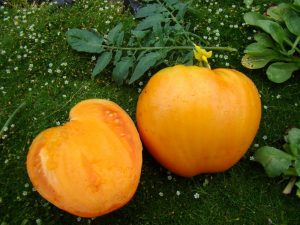 According to responses of summer residents, and according to the statement of breeders, this tomato is not ill with good care. If you started your plot, do not follow the irrigation regime, do not air the greenhouse, then any variety, even the most stable, will be sick. Therefore, you always need to monitor the humidity, loosen the soil, open the greenhouse, make in time feed and remove obsessive weeds.
According to responses of summer residents, and according to the statement of breeders, this tomato is not ill with good care. If you started your plot, do not follow the irrigation regime, do not air the greenhouse, then any variety, even the most stable, will be sick. Therefore, you always need to monitor the humidity, loosen the soil, open the greenhouse, make in time feed and remove obsessive weeds.
With regard to insect pests, they are in tomato variety "Honey Giant" are available, which is typical for all mid-season varieties. Thrips, melon aphids, a bear, slugs and whitefly are harming tomatoes, of course, the Colorado potato beetle. They use two drugs against them - "Confidor", "Bison" and folk infusions. It can be a mixture of a spoon of red pepper and a bucket of water or mustard powder in the same quantities. The site is shed and use the solution for spraying. Chemical preparations are used only before flowering, as they can accumulate in the fruit.
Advantages and disadvantages
After reading the characteristics and description of the variety “Honey Giant” tomato, we can draw important conclusions about its advantages, we also need to identify the shortcomings.
Pros:
- high yield - an average of 7-8 kg per square meter, but maybe up to 15 kg;
- high quality of fruits, excellent taste and aroma, good keeping quality;
- the possibility of growing for sale;
- yellow color - health benefits;
- disease resistance.
Minuses:
- not suitable for preparing some winter dishes, juices, for canning whole;
- takes time to form, garter, pasynkovanie;
- It is demanding to fertilizers, heat.
As you can see, there are shortcomings and good qualities. But still the taste and great weight of fruits play a big role in choosing this variety.
Agrotechnology
Growing seedlings
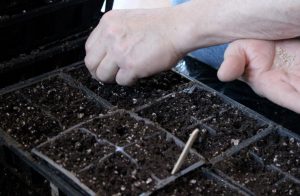 Sowing begins in March, looking at the lunar calendar. Seeds, if the manufacturer did not specify any information on dressing, you will need to cook. To do this, they are first soaked in a solution of manganese for one hour, then washed. Before planting for a couple of days, the seed is put on a day for a day or a little less in aloe juice - the proportion with water is 1⁄2. Soil or use the purchase of Solanaceae, or your own - the land from the garden, mixed with humus and peat in equal parts. Before planting, any complex preparation with a high content of nitrogen, potassium and phosphorus is also added to the soil. The soil is spilled with boiling water, sown seeds 1 cm, moistened and covered with foil.
Sowing begins in March, looking at the lunar calendar. Seeds, if the manufacturer did not specify any information on dressing, you will need to cook. To do this, they are first soaked in a solution of manganese for one hour, then washed. Before planting for a couple of days, the seed is put on a day for a day or a little less in aloe juice - the proportion with water is 1⁄2. Soil or use the purchase of Solanaceae, or your own - the land from the garden, mixed with humus and peat in equal parts. Before planting, any complex preparation with a high content of nitrogen, potassium and phosphorus is also added to the soil. The soil is spilled with boiling water, sown seeds 1 cm, moistened and covered with foil.
After germination, the film is removed, the seedlings are placed on the sunny window, so that the light reaches at least 8 hours a day. For additional lighting lamps are put. In the phase of 3-4 leaves, the strongest shoots are selected and dive into separate cups in a clean and nutritious soil. Two weeks after thinning, urea is applied as a nitrogen feed for green mass growth. The transfer to the street and to the greenhouse is carried out when the temperature at night does not fall below 15 degrees, since if it is below 14, the seedlings will stop growth and development for a long time.
See also: Practical variety of tomato "White filling 241"
Transfer to a permanent place
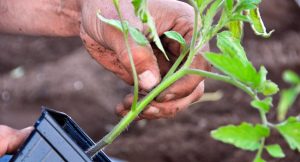 The plot is prepared in two weeks at the rate of 2-3 square meters per square bush. Immediately put support. Land need to dig, remove plant residues. Next, add humus, ash, lime, if the soil is acidic, and flatten all the rows. Superphosphate is added to the well when planted. If the soil is heavy, then peat or sand is applied to the entire plot or to each hole. The earth should be loose and airy. Watered the wells with warm water. Seedlings are planted after pre-hardening for two weeks.
The plot is prepared in two weeks at the rate of 2-3 square meters per square bush. Immediately put support. Land need to dig, remove plant residues. Next, add humus, ash, lime, if the soil is acidic, and flatten all the rows. Superphosphate is added to the well when planted. If the soil is heavy, then peat or sand is applied to the entire plot or to each hole. The earth should be loose and airy. Watered the wells with warm water. Seedlings are planted after pre-hardening for two weeks.
Care
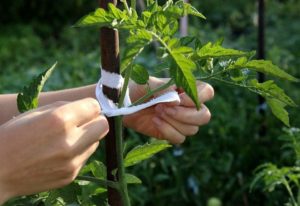 Two weeks after the transfer, the seedlings are fed potassium nitrate, in which there is potassium, phosphorus. Then, after two weeks, make manure - 1/10 with water. After two weeks of complex fertilizer. Then you can alternate these dressings. Every week stepchildren are removed, after each watering the plot is loosened and the greenhouse is aired. Carefully follow the insects, we have already mentioned about them.When the stem grows to about one and a half meters, it is pinched. Remember that the bushes form, removing all stepchildren, except for one in the upper sinus. Masking is done in the evening, not in the heat or after watering.
Two weeks after the transfer, the seedlings are fed potassium nitrate, in which there is potassium, phosphorus. Then, after two weeks, make manure - 1/10 with water. After two weeks of complex fertilizer. Then you can alternate these dressings. Every week stepchildren are removed, after each watering the plot is loosened and the greenhouse is aired. Carefully follow the insects, we have already mentioned about them.When the stem grows to about one and a half meters, it is pinched. Remember that the bushes form, removing all stepchildren, except for one in the upper sinus. Masking is done in the evening, not in the heat or after watering.
When the fruits begin to ripen, you need to remove some of the leaves so that they do not interfere. With growth and development, not only the trunk is tied up, but also supports are placed under the branches with the harvest. For the prevention of deficiency of elements and for immunity, you can shed the area with a solution of manganese. Foliar spraying variety does not like. Watering and feeding make the root. Tomato "Honey Giant", according to reviews, is not so difficult to grow. Photos of the bush show the beauty of tomatoes, the yield will delight you with good care always.
See also: The best varieties of tomatoes for open ground
Video: How to grow good tomatoes


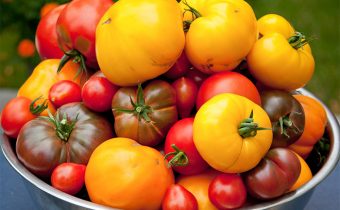
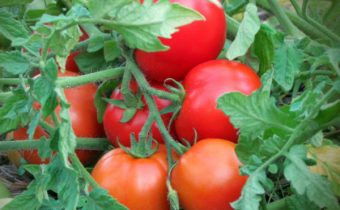
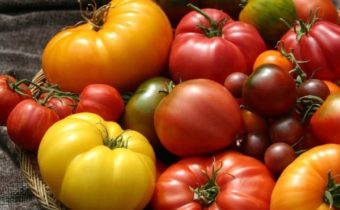
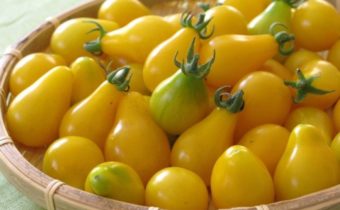
Lyudmila Isaeva
I love yellow tomatoes, which not only delight the gaze with its bright yellow color, but also very tasty in salads. In order for tomatoes to develop well and produce a lot of fruits, I sometimes water them with fertilizer from yeast diluted in water. The soil for planting should be well fertilized and loose. I water only with warm water so as not to cause rotting of the roots. This variety is really resistant to diseases, and it is immediately noticeable compared to the red and pink varieties.